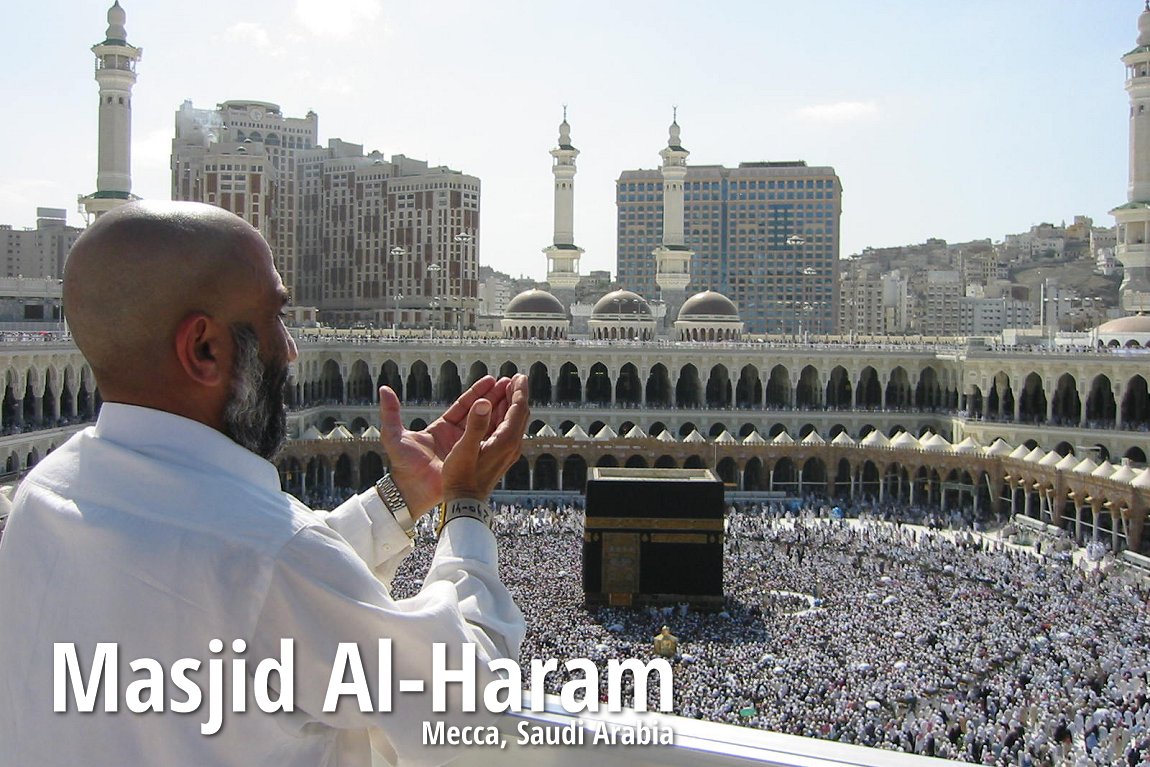 Masjid Al-Haram, Mecca
Masjid Al-Haram, MeccaSource: https://commons.wikimedia.org/wiki/File:
Supplicating_Pilgrim_at_Masjid_Al_Haram._Mecca,_Saudi_Arabia.jpg
Author: Ali Mansuri

Supplicating_Pilgrim_at_Masjid_Al_Haram._Mecca,_Saudi_Arabia.jpg
Author: Ali Mansuri

Masjid al-Haram is the holiest and largest mosque in the world. Located in the city of Mecca, it is the mosque that encompasses the Kaaba, the object to which Muslims from around the world face when offering their daily prayers.
Also known as the Grand Mosque or the Sacred Mosque, the Masjid al-Haram covers 356,800 sq meters or 88 acres. It has indoor as well as outdoor prayer spaces, allowing four million people to congregate in one spot, the largest annual gatherings of humanity anywhere in the world.
According to Islamic tradition, Masjid al-Haram was first built by angels before the creation of mankind. Time and again it was damaged by the elements. It was also here that, according to Islamic belief, Ibrahim (Abraham) and his son Ismail (Ishmael) were ordered by Allah to build the mosque and the Kaaba. The only remaining piece of Ibrahim's mosque is the Black Stone on the eastern corner of the Kaaba.
The Masjid al-Haram has been renovated and expanded many times throughout the history of Islam. The first renovation in recorded history took place in AD 692. It included the heightening of the mosque's outer walls and the embellishment of its ceiling.
By AD 700, the original wooden columns of the mosque have been replaced with marble columns. The prayer hall was extended and a minaret built. Three more minarets were to follow, along with more prayer space, as Islam spread across the Middle East, bringing with it an annual influx of pilgrims.
Restorations conducted during the reign of Sultan Selim II in 1570 are some of the oldest features of Masjid al-Haram that are still standing today. They are older even than the Kaaba (discounting the Black Stone), as the present Kaaba is the fourth incarnation made in 1629.
In the 1620's Masjid al-Haram underwent another round of renovation, with three more minarets added to the complex and the marble flooring retiled. From then on, the mosque remained unaltered for three centuries.
Renovations to Masjid al-Haram conducted under the reign of King Abdul Aziz included the replacement of the support columns, refurnishing of the ceiling and flooring. Also during the first Saudi renovation, four more minarets were added.
Under the reign of King Fahd, a second Saudi renovation was undertaken. A new wind and outdoor prayer space were added. This was carried out between 1982 and 1988.
The third Saudi renovation, between 1988 and 2005, included the construction of more minarets, more prayer area within and around the mosque, and the King's residence overlooking the mosque. Also added are 18 more gates, three domes and 500 marble columns.
With the death of King Fahd, Masjid al-Haram now enters the fourth Saudi renovation phase under King Abdullah. This phase of renovation began in 2007 and is expected to continue until 2020. It will increase the capacity of the mosque by a further 35%.
A replica of Masjid al-Haram can be seen at Taman Tamadun Islam, an Islamic-themed monument park in Kuala Terengganu, Malaysia.
 Latest updates on Penang Travel Tips
Latest updates on Penang Travel Tips
 Map of Roads in Penang
Map of Roads in Penang
Looking for information on Penang? Use this Map of Roads in Penang to zoom in on information about Penang, brought to you road by road.
Copyright © 2003-2025 Timothy Tye. All Rights Reserved.

 Go Back
Go Back